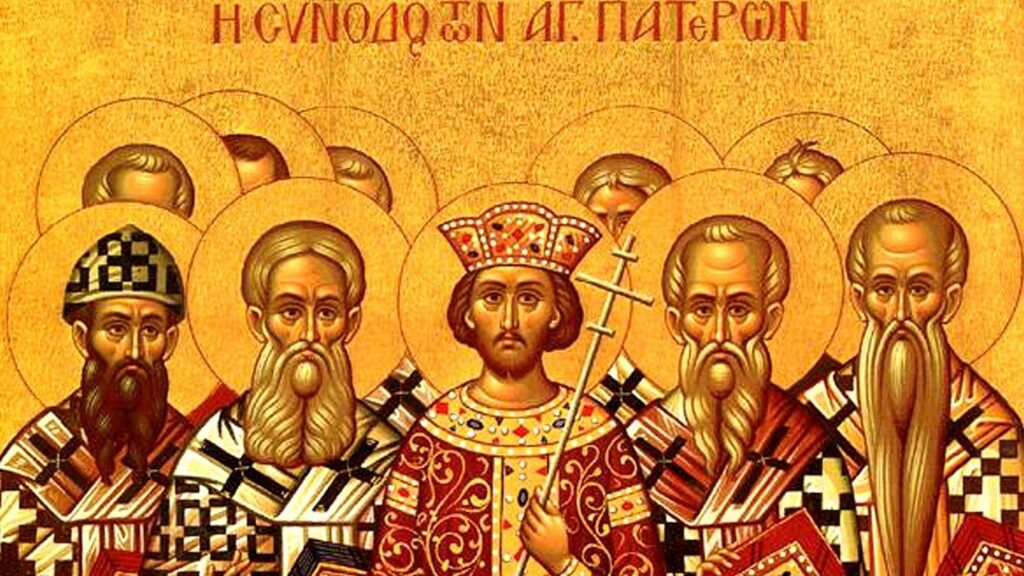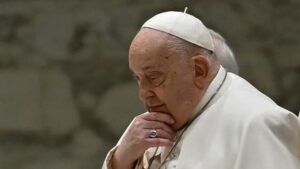The doctrinal issues addressed by the Council of Nicaea, summarized in the “Declaration of the 318 Fathers”, are above all of ecumenical importance. In it, the Fathers professed their faith in “one God, Father Almighty, Creator of all things visible and invisible; and in one Lord Jesus Christ, only-begotten Son of God, begotten of the Father, that is, of the substance of the Father. God from God, light from light, true God from true God; begotten and not created, consubstantial with the Father; through whom all things were made in heaven and on earth”. And in the Synod’s letter to the Egyptians, the Fathers announced that the first and true object of study was the fact that Arius and his followers were enemies of the faith and opposed to the law, and therefore affirmed that they had decided “by common consent to pronounce an anathema against his impious doctrine, and against the blasphemies he advances against the Son of God”.
In an interview with Cardinal Koch, Prefect of the Dicastery for Promoting Christian Unity, Vatican News of January 18, 2025, gives us an unusual perspective.
These statements set the context for the Council’s creed of faith in Jesus Christ as the Son of God, “consubstantial with the Father”. The historical background is that of a violent quarrel within Christianity at the time, particularly in the eastern part of the Roman Empire; by the early 4th century, the Christological question had become the crucial issue for Christian monotheism. The controversy revolved mainly around the question of how to reconcile the Christian profession of faith in Jesus Christ as Son of God with the equally Christian faith in a single God in the sense of the monotheistic confession.
The Alexandrian theologian Arius in particular advocated a rigorous monotheism in line with the philosophical thinking of the time and, to maintain such a rigid monotheism, excluded Jesus Christ from the concept of God. From this perspective, Christ could not be “Son of God” in the true sense of the word, but merely an intermediary used by God for the creation of the world and for his relationship with mankind. The Council Fathers rejected this model of rigid philosophical monotheism disseminated by Arius, opposing it with the creed that Jesus Christ, as Son of God, is “consubstantial with the Father”.
With the term “homoousios”, the Council Fathers wanted to express the deeper mystery of Jesus Christ, to whom Sacred Scripture bears witness as the faithful Son of the Father, with whom he is intimately united in prayer. Indeed, it is in prayer that Jesus appears most clearly as the Son of the heavenly Father. In the New Testament, it is above all the evangelist Luke who presents Jesus in his earthly life as the Son of God in constant prayer, who has dialogue with the heavenly Father as his existential core and lives with Him in profound unity. Jesus lived so much in and of prayer that his whole life and work can be defined as a single prayer. Without this attitude of prayer, it is absolutely impossible to understand the figure of Jesus Christ. This is precisely what the Fathers of the Council of Nicaea understood with great sensitivity, using the term “homoousios” to offer the right interpretation of Jesus’ prayer and the deeper reading of his life and death, marked at every moment by dialogue with the Father.
Through the term “homoousios“, the Council of Nicaea did not “Hellenize” the biblical faith by subjecting it to a foreign philosophy, but grasped the incomparable newness that had become visible in Jesus’ prayer to the Father. Rather, it was Arius who conformed the Christian faith to the philosophical thought of the time, while the Council of Nicaea took up the philosophy of the time to express what was characteristic of the Christian faith. In the Nicene Creed, the Council expressed itself once again like Peter and with Peter in Caesarea Philippi: “You are the Christ, the Son of the living God” (Mt 16:16).
The Council’s Christological creed became the basis of the common Christian faith. The Council is particularly important because it took place at a time when Christianity had not yet been torn apart by the many divisions that were to follow. The Nicene Creed is common not only to the Eastern Churches, the Orthodox Churches and the Catholic Church, but also to the ecclesial communities born of the Reformation, so its ecumenical importance should never be underestimated. In fact, restoring the unity of the Church requires agreement on the essential contents of the faith, not only between the Churches and ecclesial communities of today, but also with the Church of the past and, in particular, with its apostolic origins. The unity of the Church is founded on the apostolic faith, which is transmitted in baptism and entrusted to each new member of the Body of Christ.
The foundation of Christological spiritual ecumenism
Since unity can only be found in common faith, the Christological confession of the Council of Nicaea appears to be the foundation of spiritual ecumenism. This is, of course, a pleonasm. Christian ecumenism is either spiritual or it is not. This is why the Second Vatican Council’s Decree on Ecumenism defines spiritual ecumenism as “the soul of all ecumenism” (UR, n. 8). This was already evident in the early days of the ecumenical movement, with the introduction of the Week of Prayer for Christian Unity, itself an ecumenical initiative. From its very beginnings, the ecumenical movement has been a movement of prayer. It was prayer for Christian unity that paved the way for the ecumenical movement.
The centrality of prayer underlines the fact that ecumenical commitment is first and foremost a spiritual duty, undertaken in the conviction that the Holy Spirit will bring to completion the ecumenical work he has begun and show us the way. This is particularly true when spiritual ecumenism is conceived and implemented as Christological ecumenism, of which the Council of Nicaea represents a solid foundation. The heart of Christian ecumenism lies in the common conversion of all Christians and Churches to Jesus Christ, in whom unity is already given. Christian ecumenism can only make credible progress if Christians return together to the source of faith, which can only be found in Jesus Christ, as professed by the Council Fathers at Nicaea.
In this way, Christian ecumenism corresponds more closely to the will of the Lord, common to all Christians, who in his priestly prayer prayed for the unity of his disciples: “That they may all be one” (Jn 17:21). What is striking about Jesus’ prayer is that he neither commands unity from his disciples, nor demands it, but prays for it by addressing the heavenly Father. This prayer reveals what the ecumenical quest to re-establish unity in the light of faith is, and must be. Christian ecumenism can be nothing other than the adherence of all Christians to the Lord’s priestly prayer, and becomes so when Christians feel, deep down, a strong desire for unity. If ecumenism is not limited to an interpersonal and philanthropic dimension, but has a truly Christological inspiration and basis, it cannot be anything other than participation in the priestly prayer of Jesus. The deepest meaning of spiritual ecumenism as Christological ecumenism is that we all let ourselves be involved in the movement of Jesus’ prayer to the heavenly Father, and thus become one. The inner home of Christian unity can only be the prayer of Jesus.
The enduring relevance of the Council
If we bear in mind these various aspects of the Council of Nicaea’s Christological confession, the need to celebrate its 1700th anniversary in ecumenical communion between all Christian Churches, and to rediscover and reaffirm its confession of faith in Jesus Christ, becomes an important imperative for ecumenism today. There’s another reason for this. If we take an honest look at the current context of faith in our latitudes, we have to recognize that we find ourselves in a situation similar to that of the 4th century, as we witness a powerful revival of Arian tendencies.
As early as the 1990s, Cardinal Joseph Ratzinger recognized a “new Arianism” as the real challenge facing contemporary Christianity. The spirit of Arianism is perceptible above all in the fact that, even today, many Christians are sensitive to all the human dimensions of the figure of Jesus of Nazareth, but have problems with the Christological confession that Jesus of Nazareth is the only Son of the Heavenly Father, and thus with the Church’s Christological faith. Today, even in the Church and in ecumenism, it is often very difficult to perceive in the man Jesus the face of God himself and to confess him as the Son of God, because we tend to see him simply as a human being, albeit a supremely good and exceptional one.
But if Jesus, as many Christians believe today, were only a man who lived two thousand years ago, he would be irretrievably relegated to the past, and only our human memory could bring him back to the present, more or less clearly. In that case, Jesus could not be the unique Son of God in whom God himself is present in our midst. Only if the Church’s confession that God himself became man is true, and that Jesus Christ is true God and true man, and thus partakes of God’s all-embracing presence, can we confess him today as “consubstantial with the Father”.
The Christian faith today stands or falls with the Christological confession of the Council of Nicaea. Dealing with this Council is therefore important, not only historically. What’s more, its creed is still relevant today, especially in the current state of the faith. And reviving its Christological confession is a challenge that must be taken up in ecumenical communion.
The search for a common Easter date
The Council of Nicaea is also ecumenically important because, in addition to the Christological confession, it dealt with disciplinary and canonical issues which, set out in twenty canons, provide a good overview of the problems and pastoral concerns of the early fourth-century Church. These include questions concerning the clergy, certain jurisdictional disputes, cases of apostasy, the situation of the Novatians, the so-called “pure” and the followers of Paul of Samosata.
The most important pastoral question was that of the date of Easter, which shows that it was already controversial in the early Church, and that various dates existed: especially in Asia Minor, Christians celebrated Easter at the same time as the Jewish Passover, on Nissan 14, and were therefore known as quartodecimans. Conversely, Christians known as Protopaschites, especially in Syria and Mesopotamia, celebrated Easter on the Sunday following the Jewish Passover. In the light of this situation, the Council of Nicaea has the merit of having found a uniform norm, expressed in the “Letter to the Egyptians”: “We also warn you that the dispute concerning the day on which the feast of Passover should be celebrated, has been happily ended by the help of your prayers“. This meant that Easter was to be celebrated in accordance with Roman practice.
In the history of Christianity, a new situation arose in the 16th century, when Pope Gregory XIII, through a fundamental calendar reform, introduced the so-called Gregorian calendar, which provides for the celebration of Easter on the Sunday following the first full moon of spring. While since then, churches in the West have calculated Easter according to this calendar, churches in the East still largely use the Julian calendar, which was also the basis for the Council of Nicaea.
Although various proposals for a common Easter date have been debated in the meantime, the issue has not yet been resolved. The Second Vatican Council had already addressed this urgent pastoral challenge in an appendix to the Constitution on the Sacred Liturgy “Sacrosanctum Concilium”, promulgated in 1963, stating that it considered “of great importance the desires of many in favor of fixing the feast of Easter on a specific Sunday and of stabilizing the calendar”. The Council declared itself in favor of “fixing the feast of Easter on a specific Sunday in the Gregorian calendar, with the assent of those to whom this question is important, especially of the brethren separated from communion with the Apostolic See“. Pope Francis has repeatedly shown the same spirit of openness.
The 1700th anniversary of the Council of Nicaea offers a special opportunity to revisit the question of the date of Easter, particularly as in 2025 it will fall on the same day, April 20, for both Eastern and Western Churches. It is therefore understandable that the ecumenical community has awakened a desire to seize the great anniversary of the Council as an opportunity to resume and intensify efforts to find a common date for Easter.
Synodal style
From an ecumenical point of view, the Council of Nicaea is also of particular importance because it documents the way in which the then heated debate on the Orthodox Christological confession and the pastoral and disciplinary question of the date of Easter were discussed and decided in a synodal style. Church historian Eusebius of Caesarea, who was himself one of the Council Fathers and regarded the Council of Nicaea as a new Pentecost, expressly pointed out that the first servants of God gathered at the Council came “from all the Churches of Europe, Africa and Asia”. The Council of Nicaea can therefore be seen as the beginning, at the level of the universal Church, of the synodal way of discussing problems and making decisions.
The 1700th anniversary of the Council of Nicaea should therefore also be seen as an invitation and a challenge to learn from history and deepen synodal thinking, anchoring it in the life of the Church. The current revitalization of the synodal dimension of the Church does not seem new; rather, it can be linked to the synodal traditions of the early Church. The famous Church Father John Chrysostom already explained that “Church” is a name “which indicates a common path” and that Church and Synod are therefore “synonymous”.
We can also learn a lot from each other in ecumenical dialogues, since synodality has developed in different ways in different Churches and ecclesial communities. This was demonstrated, for example, by the international ecumenical colloquia organized by the Institute for Ecumenical Studies of the Pontifical University of St. Thomas Aquinas in preparation for the Synod of Bishops, focusing on concepts and experiences of synodality in the Christian Churches of East and West. These colloquia were entitled “Listening to the East” and “Listening to the West” respectively . These encounters significantly demonstrated that the Catholic Church can be enriched by the theological thinking and experiences of other Churches in its efforts to revive a synodal way of life and strengthen its structures, and that deepening the synodal dimension in Catholic theology and practice represents an important contribution that the Catholic Church can make to ecumenical dialogues, also with a view to a finer understanding of the close link between synodality and primacy.
The ecumenical dimension of synodality was also particularly emphasized at the General Assembly of the Synod of Bishops. Pope Francis has repeatedly recalled the interdependence between synodality and the ecumenical journey, affirming that the synodal journey undertaken by the Catholic Church must be ecumenical, just as the ecumenical journey is synodal. The way in which synodality is presented and discussed in the Catholic Church is therefore part of an ecumenical perspective.
The authority of Church and State
There is, however, a fundamental difference between current efforts to revitalize synodality and the Council of Nicaea that should not be overlooked. At first glance, it may seem insignificant, but its relevance becomes particularly apparent when viewed from an ecumenical perspective. The historical fact is that the Council of Nicaea was convened by a state authority, and more specifically by the Emperor Constantine. Constantine saw the dispute over the Christological confession as a major threat to his plan to consolidate the unity of the empire on the basis of the unity of the Christian faith. He saw the possibility of an imminent division of the Church primarily as a political problem. Yet he was far-sighted enough to realize that the unity of the Church had to be resolved not politically, but ecclesiastically and theologically. To reconcile the communities then in conflict, he convened the first Ecumenical Council in the city of Nicaea in Asia Minor, near the imperial residence of Nicomedia.
One of the unfortunate consequences of this approach is that, after Constantine, the emperors, particularly his son Constantius, resolutely pursued a policy of turning away from the creed of the Council of Nicaea and once again promoting the heresy of Arius. This meant that the decision of the Council of Nicaea did not put an end to the debate on the compatibility between the profession of faith in the divinity of Jesus Christ and the monotheistic conviction of the 4th century, but reignited the controversy over the nature of Jesus Christ as belonging to God or to Creation. These developments even prompted Basil, the famous bishop of Caesarea, to compare the situation following the Council of Nicaea to a nightly naval battle in which all fought against all, concluding that the conciliar controversies had given rise within the Church to “terrible disorder and confusion” and “incessant chatter”.
From an ecumenical point of view, it is important to note that as a result of this historical context, different conceptions of the relationship between Church and State have emerged within the Church of the East and the Church of the West. The latter had to learn from a long and complex history that the appropriate way to shape its relationship with the state was to ensure a separation between the two, while maintaining a partnership. In the Church of the East, by contrast, the model of a close link between the state government and the ecclesiastical hierarchy has become widespread. Generally referred to as the “symphony between Church and State“, this model is particularly evident in the Orthodox concepts of autocephaly and canonical territory.
The different traditions of shaping Church-State relations have often taken place in the context of conflicts between the Eastern and Western Churches throughout history. They have also had a significant impact on ecumenical relations. To date, however, they have been among the least discussed topics in ecumenical dialogues. It will therefore be crucial to include them at the top of the ecumenical agenda, especially in view of the major anniversary of the Council of Nicaea in 2025.
This is why the 1700th anniversary of the Council of Nicaea represents not only a fruitful opportunity to renew, in ecumenical communion, the profession of faith in Jesus Christ, Son consubstantial with the Father, but also an important challenge, namely that of clearly addressing and discussing the issues of the past which, while still open, have not been sufficiently addressed in ecumenical debates held to date. If opportunities and challenges are put on an equal footing, the 1700th anniversary of the Council of Nicaea could truly prove to be a watershed for the future of ecumenism.




